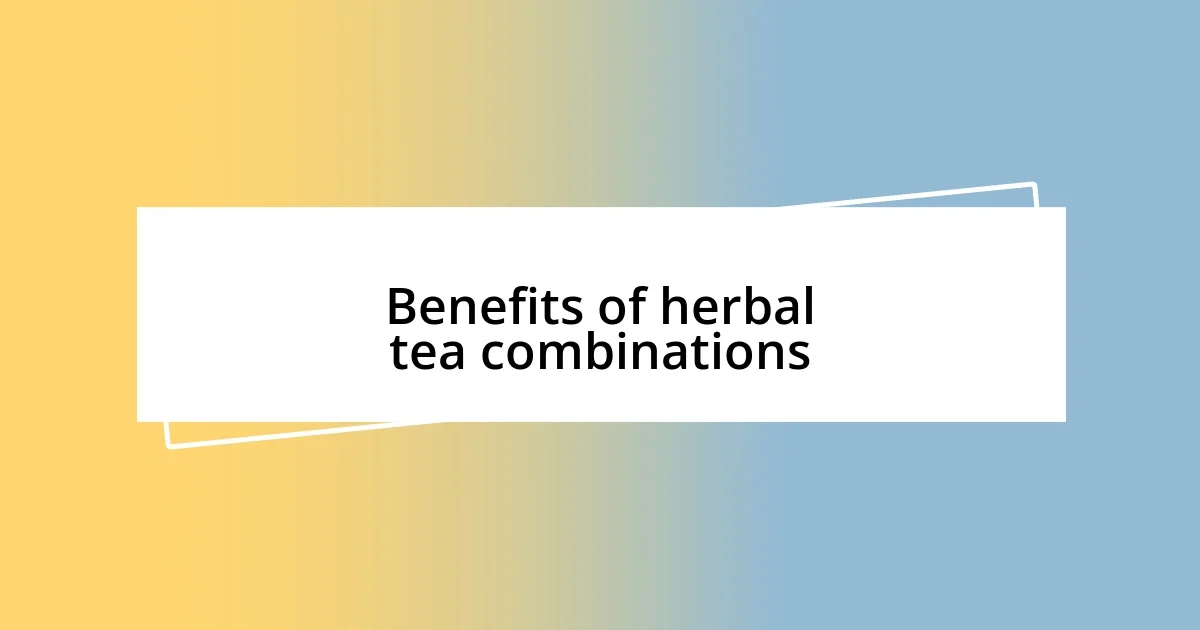Key takeaways:
- Herbal tea pairing enhances flavor, aroma, and health benefits, allowing for a creative tea-drinking experience.
- Combining herbs can lead to unique emotional connections and cultural explorations through flavors.
- Experimenting with unexpected ingredients and layering flavors can transform ordinary tea moments into extraordinary experiences.

Introduction to herbal tea pairing
Pairing herbal teas is like creating a culinary masterpiece; it requires a thoughtful approach to flavor, aroma, and health benefits. I recall my first attempt at pairing, feeling both excited and slightly nervous, as I ventured to mix chamomile with mint. The soothing qualities of chamomile blended beautifully with the refreshing crispness of mint, creating a delightful experience that made me wonder: what other combinations could elevate my tea moments?
As I explored more, I discovered that each herbal tea carries its own unique story and potential health benefits. For instance, hibiscus is not only gorgeous to look at, but its tart flavor can pair beautifully with spices like cinnamon. This pairing not only tantalizes the taste buds but also warms the spirit—a perfect example of how tea can be an emotional experience, right?
It’s fascinating how pairing herbal teas can deepen our appreciation for the flavors and traditions behind each blend. Whenever I experiment with new pairings, it feels like embarking on a little adventure, reminding me of those cozy afternoons spent sipping tea with friends while sharing stories. What might your next pairing reveal about your tastes and preferences?

Benefits of herbal tea combinations
When it comes to herbal tea combinations, one of the most notable benefits is the enhancement of flavor profiles. For instance, I once combined ginger and lemon balm. The spicy warmth of ginger intermixed perfectly with the soothing citrusy notes of lemon balm. This blend not only delighted my palate but also offered a comforting sensation on a cold day; it made my kitchen feel like a cozy retreat.
Moreover, the synergistic effects of different herbs can lead to significant boosts in health benefits. One memorable experiment for me was mixing lavender with chamomile. Not only did this duo create a calming aroma that enveloped my senses, but it also promoted relaxation and sleep—perfect for winding down after a long day. I found myself sipping this blend before bedtime, and I believe it truly became part of my nightly ritual.
Lastly, pairing herbs can also introduce you to new cultural traditions. I vividly recall my experience with a Moroccan-inspired blend of mint tea and rose petals. It was more than just tea; it felt like I was immersing myself in a cultural experience. Each sip took me to a bustling market, filled with fragrant aromas, and a sense of connection to a different world. These combinations often invite us to explore not only flavor but also the rich stories behind each herbal blend.
| Herb Combination | Benefits |
|---|---|
| Ginger & Lemon Balm | Warmth and soothing citrus |
| Lavender & Chamomile | Calming and sleep-promoting |
| Mint & Rose Petals | Cultural richness and flavor complexity |

Choosing the right flavor profiles
Choosing the right flavor profiles can transform your herbal tea experience in the most delightful ways. I remember sitting with a friend as we sipped on a blend of rooibos and orange peel. The natural sweetness of the rooibos paired perfectly with the bright, zesty notes of orange, creating a cup that felt like a warm hug on a chilly day. There’s something magical about discovering combinations that resonate with our moods or moment; it’s like finding a melody that speaks directly to our hearts.
To pinpoint flavor profiles that truly sing together, consider the following tips:
- Contrast: Mix bold flavors like peppermint with the creamy undertones of vanilla or coconut.
- Complement: Balance earthy flavors, such as chamomile, with sweeter notes like peach or honey for an inviting aroma.
- Layering: Try combining herbs with similar characteristics, such as lemongrass and ginger, for a refreshing yet spicy fusion.
- Mood-Driven: Choose flavors based on your emotional state—chamomile for relaxation or hibiscus for a refreshing lift.
- Experiment: Don’t be afraid to try unexpected ingredients, like adding a hint of black pepper to your herbal blend for a surprising kick.
By tuning into the nuances of these profiles, you can create your own unique flavor symphonies, making your tea-drinking experience even more personal and enjoyable.

Herbal tea pairing techniques
Finding the right pairing technique for herbal teas can open up a whole new world of flavors and benefits. One technique I’ve found particularly rewarding is the idea of balancing flavors. I remember creating a blend with lemon verbena and ginger, where the bright citrus notes of the verbena danced beautifully with ginger’s heat. Each sip felt invigorating yet soothing—almost like a refreshing breeze on a warm day. Isn’t it amazing how the right combinations can uplift your spirit?
Another approach I’ve enjoyed is to think about textural contrasts. In one of my recent experiments, I mixed chia seeds into a cozy chai brew. The seeds provided a delightful burst in contrast to the smoothness of the tea. It made me smile, realizing how the unexpected could elevate a familiar comfort. Have you ever tried combining textures in your teas? It can surprise you in the best of ways!
Lastly, I find that incorporating seasonal ingredients can enhance the experience tremendously. For example, during autumn, I paired warm spices like cinnamon and nutmeg with rooibos, evoking the essence of the season. It was like wrapping myself in a cozy blanket while sipping on memories of family gatherings. Each moment spent crafting these combinations serves as a reminder of how herbal tea can be an expression of our tastes and experiences, don’t you think?

Popular herbal tea combinations
My favorite herbal tea combinations often reflect my mood and the occasion. For instance, during a rainy afternoon, I love crafting a blend of hibiscus and mint. The tartness of hibiscus complements the coolness of mint, creating a lively yet calming drink. It’s as if each sip is encouraging me to embrace the cozy atmosphere outside while sipping something refreshing.
One memorable experience I had was blending lavender with chamomile. The floral notes of lavender wrapped around the gentle, soothing characteristics of chamomile, almost transporting me to a peaceful meadow. I recall savoring this tea while journaling my thoughts—it felt like a gentle nudge to slow down. Have you ever experienced that profound relaxation from a simple cup of tea? It’s remarkable how the right blend can ground us.
Sometimes, I venture into the more adventurous territory of spices. I remember a time when I mixed turmeric and lemongrass for a morning energizer. The earthy warmth of turmeric met the bright, citrusy kick of lemongrass in a dance of flavors that invigorated my senses. It not only woke me up but also added a splash of sunshine to my day. Have you tried experimenting with spices? The results can surprise you, and the experience often enhances the ritual of brewing tea.

Enhancing flavors with ingredients
Bringing in unexpected ingredients can really transform the flavor profile of herbal teas. I once decided to add a pinch of black pepper to a sweet peppermint tea, and it completely changed my perspective on flavor combinations. The pepper added a subtle heat that contrasted perfectly with the sweet notes of peppermint, creating a warm sensation that lingered after each sip. Have you ever found yourself pleasantly surprised by an unusual addition?
Another delightful experiment came when I mixed fresh basil into a strawberry-infused brew. The herbal notes of basil cutting through the sweetness of the strawberries was purely sublime. It reminded me of summer days spent in my grandmother’s garden, where the scent of herbs mingled with ripe fruits, making each sip feel nostalgic and vibrant at the same time. Isn’t it incredible how certain ingredients can transport us back to cherished memories?
I often explore the idea of layering flavors, where each ingredient brings its unique essence to the mix. When I added a splash of vanilla extract to a brewed hibiscus tea, the creaminess of the vanilla blended seamlessly with the tartness of the hibiscus, resulting in a rich and comforting drink. Each sip felt like a warm hug. Have you ever experimented with layering flavors? It’s a game changer, turning an ordinary tea moment into something extraordinary.

Personal reflections on tea pairing
Pairing herbal teas offers a unique opportunity to explore not just flavors, but also emotions tied to those flavors. I remember sitting on my porch one evening, pouring myself a blend of lemon balm and ginger. The soothing properties of lemon balm coupled with the zing of ginger created a comforting warmth that felt like a hug on a chilly night. Have you ever noticed how certain teas can evoke memories and feelings tied to specific moments in your life?
I once experimented with combining rose petals and cardamom in a late-night brew. As the delicate floral notes danced with the sweet, spicy essence of cardamom, I felt transported to a cozy café I used to frequent with friends. That feeling of connection and nostalgia washed over me; it was as if each sip was a bridge back to those carefree moments. Isn’t it fascinating how tea can serve as a vessel for memory?
Occasionally, I indulge in creative pairings that push my boundaries. A standout moment was crafting a brew with peppermint and a splash of balsamic vinegar—yes, balsamic! The surprising tang from the vinegar added a complexity I never expected. I found myself laughing at the unexpected delight it brought. Have you ever had a flavor combination that made you smile with surprise? It’s these delightful risks that truly enrich the experience of tea pairing for me.














